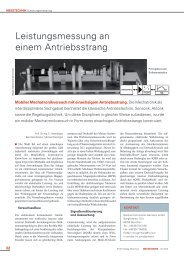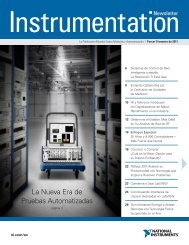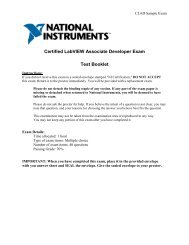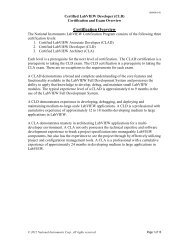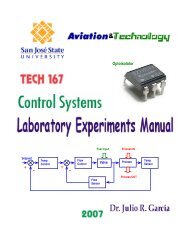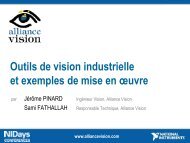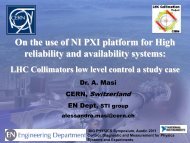CLAD Sample Exam 1 - National Instruments
CLAD Sample Exam 1 - National Instruments
CLAD Sample Exam 1 - National Instruments
Create successful ePaper yourself
Turn your PDF publications into a flip-book with our unique Google optimized e-Paper software.
Certified LabVIEW Associate Developer <strong>Exam</strong><br />
Test Booklet<br />
Page 1 of 15<br />
<strong>CLAD</strong> <strong>Sample</strong> <strong>Exam</strong><br />
Note: The use of the computer or any reference materials is NOT allowed during the exam.<br />
Instructions:<br />
If you did not receive this exam in a sealed envelope stamped "NI Certification," DO NOT ACCEPT<br />
this exam. Return it to the proctor immediately. You will be provided with a replacement exam.<br />
• Please do not detach the binding staple of any section. If any part of the exam paper is<br />
missing or detached when returned to <strong>National</strong> <strong>Instruments</strong>, you will be deemed to have<br />
failed the exam.<br />
• Please do not ask the proctor for help. If you believe the intent of a question is not clear, you<br />
may note that question, and your reasons for choosing the answer you believe best fits the<br />
question.<br />
• This examination may not be taken from the examination area or reproduced in any way.<br />
You may not keep any portion of this exam after you have completed it.<br />
<strong>Exam</strong> Details:<br />
• Time allocated: 1 hour<br />
• Type of exam items: Multiple choice<br />
• Number of exam items: 40 questions<br />
• Passing Grade: 70%<br />
IMPORTANT: When you have completed this exam, place it in the provided envelope<br />
with you answer sheet and SEAL the envelope. Give the sealed envelope to your proctor.
Page 2 of 15<br />
<strong>CLAD</strong> <strong>Sample</strong> <strong>Exam</strong><br />
Answer Sheet:<br />
To quickly check your answers against the solutions on the Solutions Page, record your answers on this<br />
Answers Sheet. Detach this page and record your answers as you go along This page is not included in<br />
the actual <strong>CLAD</strong> exam; it is included here for practice purposes only. The Solutions Page is at the end of<br />
the <strong>Sample</strong> <strong>Exam</strong>.<br />
1. _____<br />
2. _____<br />
3. _____<br />
4. _____<br />
5. _____<br />
6. _____<br />
7. _____<br />
8. _____<br />
9. _____<br />
10. _____<br />
11. _____<br />
12. _____<br />
13. _____<br />
14. _____<br />
15. _____<br />
16. _____<br />
17. _____<br />
18. _____<br />
19. _____<br />
20. _____<br />
21. _____<br />
22. _____<br />
23. _____<br />
24. _____<br />
25. _____<br />
26. _____<br />
27. _____<br />
28. _____<br />
29. _____<br />
30. _____<br />
31. _____<br />
32. _____<br />
33. _____<br />
34. _____<br />
35. _____<br />
36. _____<br />
37. _____<br />
38. _____<br />
39. _____<br />
40. _____
<strong>Sample</strong> <strong>Exam</strong> Items:<br />
Page 3 of 15<br />
<strong>CLAD</strong> <strong>Sample</strong> <strong>Exam</strong><br />
1. How do you document a VI so that the description appears in the Show Context Help<br />
popup window?<br />
a. Use the VI Properties Documentation window<br />
b. Type in the Show Context Help window<br />
c. Create a free label on the front panel<br />
d. Edit the LabVIEW help files<br />
2. Can a wire be used to pass data between loops that are intended to run in parallel?<br />
a. Yes<br />
b. No<br />
3. Which of the following describes a Tab Control?<br />
a. A control that outputs ASCII values equal to the selected tab label<br />
b. A type of enumerated control<br />
c. A control that outputs a cluster of the controls / indicators on the tabs<br />
d. A controls that outputs the tab order of the controls on the front panel<br />
4. What is an advantage of using a Strictly Typed VI refnum?<br />
a. The data types of the target VI are known at compile time<br />
b. The data types passed to the VI can change programmatically<br />
c. You can flatten the data to a string to improve code performance<br />
d. Causes dynamically loaded VIs to be loaded at the start of execution<br />
5. A coercion dot indicates that:<br />
a. The data types are consistent<br />
b. A polymorphic operation will be performed on the data<br />
c. A data buffer is created to handle data conversion<br />
d. Data values are being coerced because they are out of range
Page 4 of 15<br />
<strong>CLAD</strong> <strong>Sample</strong> <strong>Exam</strong><br />
6. Which of the following statements is true about the following block diagram?<br />
a. The loop will execute once and the iteration terminal, , will output a value<br />
of one<br />
b. The loop will execute once and the iteration terminal, , will output a value<br />
of zero<br />
c. The loop will execute infinitely and the program will have to be aborted<br />
d. The loop will not execute and the iteration terminal, , will return a null<br />
value<br />
7. Which of the following cannot be used to transfer data?<br />
a. Semaphores<br />
b. Queues<br />
c. Notifiers<br />
d. Local variables<br />
8. Which of the following terminals controls how many times a For loop executes?<br />
a.<br />
b.<br />
c.<br />
d.<br />
9. You have a control on the front panel of a VI and you need to modify one of its<br />
properties at run time. Which of the following is the best approach you would take?<br />
a. Create an implicit property node and select the property to modify<br />
b. Create a control reference, pass the reference to a property node and select the<br />
property to modify<br />
c. Create a linked shared variable and select the property to modify the property<br />
d. Create a local variable and select the property to modify<br />
10. Formula nodes accept which of the following operations?<br />
a. Basic programming language instructions Input and Print<br />
b. Embedding of SubVIs within the Formula Node<br />
c. Pre and post increment (++) and decrement (--) as in the C language<br />
d. The use of nested Formula Node structures
Page 5 of 15<br />
<strong>CLAD</strong> <strong>Sample</strong> <strong>Exam</strong><br />
11. Which of the following is the best method to update an indicator on the front panel?<br />
a. Use a Value property node<br />
b. Wire directly to the indicator terminal<br />
c. Use a local variable<br />
d. Use a functional global variable<br />
12. Which of the following functions assembles Cluster elements by their owned labels?<br />
a. Unbundle by Name<br />
b. Unbundle<br />
c. Bundle by Name<br />
d. Bundle<br />
13. What is the output of the Build Array function in the following block diagram when<br />
Concatenate Inputs is selected?<br />
a. 1-D Array of {1, -4, 3, 7, -2, 6}<br />
b. 1-D Array of {1, 7, -4, -2, 3, 6}<br />
c. 2-D Array of {{1, -4, 3, 0}, {7, -2, 6}}<br />
d. 2-D Array of {{1, -4, 3}, {7, -2, 6}}<br />
14. What is the output of the Initialize Array function after the following code has<br />
executed?<br />
a. 1-D Array of {3, 3, 3, 3}<br />
b. 1-D Array of {4, 4, 4}<br />
c. 1-D Array of {3, 4}<br />
d. 1-D Array of {4, 3}
Page 6 of 15<br />
<strong>CLAD</strong> <strong>Sample</strong> <strong>Exam</strong><br />
15. What is one disadvantage of using the State Machine VI architecture?<br />
a. A State Machine can only traverse states in order<br />
b. If two state changes occur at the same time, only the first state change will be<br />
handled and the second will be lost<br />
c. The diagram becomes significantly larger when changing from a general<br />
architecture to a State Machine<br />
d. State Machines cannot acquire data or use DAQ functions<br />
16. What is the best method to stop a While loop on an error condition?<br />
a. Compare the Status boolean of an error cluster with a constant and wire it to<br />
the Stop terminal<br />
b. Connect the error wire directly to the Stop terminal<br />
c. Create an Event structure to handle the error event<br />
d. Use the Error Handler VI to automatically handle the error<br />
17. What mechanical action of a Boolean would you use to mimic a button on a Windows<br />
dialog?<br />
a. Switch Until Released<br />
b. Switch When Released<br />
c. Latch Until Released<br />
d. Latch When Released<br />
18. Which combination of words correctly completes the following statement?<br />
Unlike __________, which display an entire waveform that overwrites the data<br />
already stored, ___________ update periodically and maintain a history of the<br />
data previously stored.<br />
a. Graphs; Charts<br />
b. Charts; Plots<br />
c. Plots; Graphs<br />
d. C harts; Graphs<br />
19. In what instance would you use the Probe tool rather than Highlight Execution?<br />
a. To see the flow of data<br />
b. To see the value of a wire in real-time<br />
c. To look into a SubVI, as the process is running<br />
d. To slowdown the VI and show data values in wires
Page 7 of 15<br />
<strong>CLAD</strong> <strong>Sample</strong> <strong>Exam</strong><br />
20. You customize a control, select Control from the Type Def. Status pull-down menu,<br />
and save the control as a .ctl file. You then use an instance of the custom control on<br />
your front panel window. If you open the .ctl file and modify the control, does the<br />
control on the front panel window change?<br />
a. Yes<br />
b. No<br />
21. You develop a SubVI that only outputs a value and need to use this SubVI in a<br />
(calling) VI. Which of the following is the best way to enforce dataflow to control the<br />
execution of the SubVI?<br />
a. Use the SubVI in a Sequence structure<br />
b. Modify the SubVI to have dummy inputs that can be used from the calling VI<br />
c. Modify the SubVI to have Error clusters that can be used from the calling VI<br />
d. Modify the SubVI to have a global variable and use it from the calling VI<br />
22. What is the value in Shift Register Answer after the following code has executed?<br />
a. 16<br />
b. 24<br />
c. 32<br />
d. 10<br />
23. Which Chart update mode should be used to draw new data from left to right, then<br />
clear the chart and draw new data again from left to right?<br />
a. Strip Chart<br />
b. Scope Chart<br />
c. Sweep Chart<br />
d. Step Chart<br />
24. Which of the following illustrates an advantage of a global variable over a local<br />
variable?<br />
a. A global variable can pass data between two independent VIs running<br />
simultaneously<br />
b. Only the global variable can pass array data, local variables cannot<br />
c. Global variables follow the dataflow model, and therefore cannot cause race<br />
conditions<br />
d. Global variables do not require owned labels to operate
Page 8 of 15<br />
<strong>CLAD</strong> <strong>Sample</strong> <strong>Exam</strong><br />
25. Which timing function (VI) is the best choice for timing control logic in applications<br />
that run for extended periods of time?<br />
a.<br />
b.<br />
c.<br />
d.<br />
26. Under which of the following conditions does a For loop stop executing?<br />
a. When a false value is present at the conditional terminal and the conditional<br />
terminal is<br />
b. When the value of the iteration terminal, , is one less than the value of the<br />
count terminal,<br />
c. When the value of the iteration terminal, , is one more than the value of the<br />
count terminal,<br />
d. None of the above<br />
27. You are inputting data that represents a circle. The circle data includes an x position,<br />
a y position, and a radius. All three pieces of data are double-precision. In the future,<br />
you might need to store the color of the circle, represented as an integer. How should<br />
you represent the circle on your front panel window?<br />
a. T hree separate controls for the two positions and the radius.<br />
b. A cluster containing all of the data.<br />
c. A type definition containing a cluster.<br />
d. A n array with three elements.<br />
28. Which of the following will cause an event to be captured by the LabVIEW Event<br />
Structure?<br />
a. Changing a value on a Front Panel control via a mouse click<br />
b. Update of a Front Panel control using a property node<br />
c. Programmatic update of a Front Panel control via a control reference<br />
d. Using VI Server to update a Front Panel control
Page 9 of 15<br />
<strong>CLAD</strong> <strong>Sample</strong> <strong>Exam</strong><br />
29. Which of the following does not conform to data flow programming paradigm?<br />
a. Shift Registers<br />
b. Tunnels<br />
c. SubVIs<br />
d. Local Variables<br />
30. Y ou must store data that other engineers must analyze with M icrosoft E xcel. W hich<br />
file storage format should you use?<br />
a. T ab-delimited A SC I I<br />
b. C ustom binary format<br />
c. TDM<br />
d. Datalog<br />
31. What is the result of the following Array addition?<br />
a. 1-D Array of {80, 20, 40, 10, -60}<br />
b. 1-D Array of {120, 30, -60}<br />
c. 1-D Array of {120, 30}<br />
d. 2-D Array of {{120, 90, 20}, {60, 30, -40}}<br />
32. Which of the following statements is false?<br />
a. A SubVI connector pane defines where to wire inputs and outputs<br />
b. The color of a SubVI connector pane terminal matches the data type it is<br />
connected to<br />
c. You must have an icon/connector to use a SubVI<br />
d. A SubVI icon can be edited from the functions palette<br />
33. The most efficient method for creating an array is:<br />
a. Using a For loop with Auto-indexing<br />
b. Placing a build array function in a While loop<br />
c. Initializing an array and then replacing elements in a While loop<br />
d. Using a While loop with Auto-Indexing
Page 10 of 15<br />
<strong>CLAD</strong> <strong>Sample</strong> <strong>Exam</strong><br />
34. The following block diagram represents which common type of VI architecture?<br />
.<br />
a. Multiple Case Structure VI<br />
b. General VI<br />
c. State Machine VI<br />
d. Parallel Loop VI<br />
35. Which of the following statements is true about the iteration terminal<br />
a. It returns the number of times the loop has executed<br />
b. It returns the number of times the loop has executed, plus one<br />
c. It returns the number of times the loop has executed, minus one<br />
d. It returns a constant number<br />
36. For implementing state diagrams that allow future application scalability, the best<br />
choice for a base structure is?<br />
a. Sequence structure<br />
b. Case structure<br />
c. Formula node<br />
d. Object-Oriented structure
Page 11 of 15<br />
<strong>CLAD</strong> <strong>Sample</strong> <strong>Exam</strong><br />
37. Which of the following Block Diagrams could produce this result in Waveform<br />
Graph?<br />
a.<br />
b.<br />
c.
d.<br />
Page 12 of 15<br />
<strong>CLAD</strong> <strong>Sample</strong> <strong>Exam</strong>
Page 13 of 15<br />
<strong>CLAD</strong> <strong>Sample</strong> <strong>Exam</strong><br />
More than one answer may be correct for these questions. Circle ALL of the correct<br />
answers.<br />
38. If an input name on the Show Context Help window is in bold for a SubVI, which of<br />
the following conditions are true?<br />
a. Input values must be scalar.<br />
b. An input is recommended, but not required.<br />
c. An input is required.<br />
d. A broken run arrow will result unless the input is wired.<br />
39. Which of the following apply to Property Nodes?<br />
a. Property Nodes allow attributes of front panel objects to be programmatically<br />
manipulated.<br />
b. Property Nodes can be used to update the values contained in a front panel<br />
object.<br />
c. More than one Property Node can be used for a single front panel object.<br />
d. Property Nodes contained in a SubVI will always cause the front panel to be<br />
loaded in memory.<br />
40. Which VI memory components are ALWAYS resident for a SubVI?<br />
a. Data Space<br />
b. Front Panel<br />
c. Block Diagram<br />
d. Code
Page 14 of 15<br />
<strong>CLAD</strong> <strong>Sample</strong> <strong>Exam</strong><br />
Solutions Page:<br />
Below are the answers and links to additional resources for the <strong>CLAD</strong> <strong>Sample</strong> <strong>Exam</strong>. To quickly check<br />
your answers, record them on the Answer Sheet, detach the Answer Sheet, and compare it, side-by side,<br />
with the Solutions Page. This answer page is not included in the actual <strong>CLAD</strong> exam; it is included here<br />
for practice purposes only.<br />
Question Answer Resources on Topic<br />
1 A Developing User Documentation<br />
2 B Parallel FOR Loops<br />
3 B Creating Tab Controls<br />
4 A Control References: Overview<br />
5 C How Does LabVIEW Round and Coerce Values?<br />
6 C Tutorial: For Loops and While Loops<br />
7 A Application Design Patterns: Master/Slave<br />
8 D Tutorial: For Loops and While Loops<br />
9 A Control References: Overview<br />
10 C Formula Node Syntax<br />
11 B Tutorial: Front Panel<br />
12 C Tutorial: Arrays and Clusters<br />
13 A How to Concatenate Multiple Arrays in LabVIEW<br />
14 A Tutorial: Arrays and Clusters<br />
15 B Application Design Patterns: State Machines<br />
16 B Tutorial: For Loops and While Loops<br />
17 D Mechanical Action of Buttons<br />
18 A What Is the Difference Between Graphs and Charts in LabVIEW?<br />
19 B Tutorial: Debugging Tips and Tricks<br />
20 B Creating Custom Controls, Indicators, and Type Definitions<br />
21 C Tutorial and Video: Dataflow, SubVI, and Parallelism in NI LabVIEW<br />
22 C Tutorial: Timing, Shift Registers, and Case Structures<br />
23 B Chart Update Modes in LabVIEW and Measurement Studio<br />
24 A Are LabVIEW global variables good or bad, and when is it OK to use them?<br />
25 C Timing VIs and Functions<br />
26 B Tutorial: For Loops and While Loops<br />
27 C Creating Custom Controls, Indicators, and Type Definitions, Tutorial: Arrays<br />
and Clusters<br />
28 A Event-Driven Programming in LabVIEW<br />
29 D Tutorial: Local Variable, Global Variable, and Race Conditions<br />
30 A Appending Data to an Excel Spreadsheet Using Write to Spreadsheet File.vi<br />
Does Not Update the File.<br />
31 C Tutorial: Arrays and Clusters<br />
32 D Tutorial and Video: Dataflow, SubVI, and Parallelism in NI LabVIEW<br />
33 A Tutorial: Arrays and Clusters<br />
34 C Application Design Patterns: State Machines<br />
35 C Tutorial: For Loops and While Loops<br />
36 B Tutorial: Timing, Shift Registers, and Case Structures
Page 15 of 15<br />
<strong>CLAD</strong> <strong>Sample</strong> <strong>Exam</strong><br />
37 A Array Functions, For Loop and While Loop Structures<br />
38 C,D Tutorial and Video: Dataflow, SubVI, and Parallelism in NI LabVIEW<br />
39 A,B,C,D Property Node<br />
40 A,D Tutorial and Video: Dataflow, SubVI, and Parallelism in NI LabVIEW



